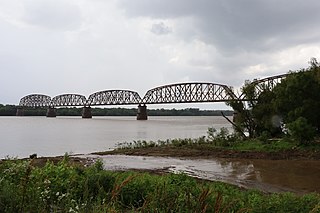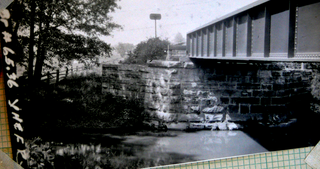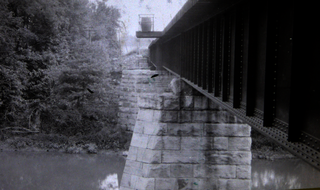
The Lethbridge Viaduct, commonly known as the High Level Bridge, is a railway trestle bridge over the Oldman River in Lethbridge, Alberta, Canada. Constructed between 1907 and 1909 by the Canadian Pacific Railway, it is the largest railway structure in Canada and the largest of its type in the world, and is still regularly maintained and used over a century since its construction.

The Delaware, Lackawanna and Western Railroad, also known as the DL&W or Lackawanna Railroad, was a U.S. Class 1 railroad that connected Buffalo, New York, and Hoboken, New Jersey, and by ferry with New York City, a distance of 395 miles (636 km). The railroad was incorporated in Pennsylvania in 1853, and created primarily to provide a means of transport of anthracite coal from the Coal Region in Northeast Pennsylvania to large coal markets in New York City. The railroad gradually expanded both east and west, and eventually linked Buffalo with New York City.

A truss bridge is a bridge whose load-bearing superstructure is composed of a truss, a structure of connected elements, usually forming triangular units. The connected elements, typically straight, may be stressed from tension, compression, or sometimes both in response to dynamic loads. There are several types of truss bridges, including some with simple designs that were among the first bridges designed in the 19th and early 20th centuries. A truss bridge is economical to construct primarily because it uses materials efficiently.

The Delaware River Joint Toll Bridge Commission (DRJTBC) is a bistate, public agency that maintains and operates river crossings connecting the U.S. states of Pennsylvania and New Jersey. The agency's jurisdiction stretches roughly 140 miles (230 km) along the Delaware River from Philadelphia and Bucks County in southeast Pennsylvania and then north through the Lehigh Valley and to Pennsylvania-New York state border.

The Warren Railroad was a railroad in Warren County, New Jersey, that served as part of the Delaware, Lackawanna and Western Railroad's mainline from 1856 to 1911.
The Lehigh and New England Railroad was a Class I railroad located in Northeastern United States that acted as a bridge line. It was the second notable U.S. railroad to file for abandonment in its entirety after the New York, Ontario and Western Railway. It was headquartered in Philadelphia.

The Fort Wayne Railroad Bridge, listed as the Pennsylvania Railroad Bridge on the National Register of Historic Places, is a double-deck steel truss railroad bridge spanning the Allegheny River in Pittsburgh, Pennsylvania.

Tunkhannock Creek Viaduct is a concrete deck arch bridge on the Nicholson Cutoff rail line segment of the Norfolk Southern Railway Sunbury Line that spans Tunkhannock Creek in Nicholson, Pennsylvania. Measuring 2,375 feet (724 m) long and towering 240 feet (73.15 m) when measured from the creek bed, it was the largest concrete structure in the world when completed in 1915 and still merited "the title of largest concrete bridge in America, if not the world" 50 years later.

The Wilsonville railroad bridge is a steel truss bridge that crosses the Willamette River at Wilsonville, Oregon, United States. This 1,220-foot-long (370 m) structure was finished in 1975 to replace a 1907 bridge at the same location and carries rail traffic for the Portland and Western Railroad. The original bridge was built to carry the Oregon Electric Railway across the river near the Boones Ferry.

The Hares Hill Road Bridge is a single-span, wrought iron, bowstring-shaped lattice girder bridge. It was built in 1869 by Moseley Iron Bridge and Roof Company and is the only known surviving example of this kind. The bridge spans French Creek, a Pennsylvania Scenic River.

The Lake Oswego Railroad Bridge is a truss railroad bridge that spans the Willamette River between Lake Oswego, Oregon and Oak Grove, Oregon. Owned by the Union Pacific Railroad, it is currently leased by the Portland and Western Railroad and carries the Milwaukie branch.

The Metropolis Bridge is a railroad bridge which spans the Ohio River at Metropolis, Illinois. Originally built for the Chicago, Burlington and Quincy Railroad, construction began in 1914 under the direction of engineer Ralph Modjeski.

The Jackson Branch Bridge No. 15, also known as the Tecumseh Railroad Bridge due to its close proximity to the city of Tecumseh, is a historic railway deck truss bridge that spans the River Raisin in rural Raisin Charter Township in Lenawee County, Michigan. The bridge was added to the National Register of Historic Places on December 4, 2001.

A balloon flange girder or (colloquially) balloon topper is a form of vertical I-beam wrought iron plate girder, where the top flange, instead of being a simple flat plate, is extended into a hollow tube. When a girder is subjected to a positive bending moment the top flange acts in compression making a flat plate flange more susceptible to local buckling than the balloon flange is.

The Tuscarora Creek bridge is a 63.5-foot (19.4 m) single-span, steel, through-girder bridge with a floor beam/stringer system supporting a 12-inch (300 mm)-thick concrete slab south of Walkersville, Maryland. Originally constructed by the Frederick and Pennsylvania Line Railroad Company (F&PL) in 1872. It was later rebuilt by the Pennsylvania Railroad in 1907 as a thru girder concrete deck bridge using an older bridge from the Northern Central Railway. In 1915, the bridge was surveyed as part of the Interstate Commerce Commission's effort to establish freight rates for the Parent railroad.

The Little Pipe Creek bridge and viaduct is a 705-foot (215 m) continuous truss bridge with a main span and 19 viaduct sections as well as an active railroad trestle crossing Little Pipe Creek south of Keymar, Maryland. Originally constructed by the Frederick and Pennsylvania Line Railroad Company (F&PL). Construction on the trestle began in late 1871 and continued until April 1872.

The Monocacy River Railroad Bridge and Viaduct is a 326-foot (99 m) open deck steel girder bridge with two main spans crossing the river and two viaduct sections crossing the floodplain, south of Walkersville, Maryland. Originally constructed by the Frederick and Pennsylvania Line Railroad Company (F&PL). Construction began in late 1871, and continued until July 1872 when the railroad opened that year. It was rebuilt by the Pennsylvania Railroad prior first in 1900-1905 as an open deck riveted iron plate under girder bridge. In 1915, the bridge was surveyed as part of the Interstate Commerce Commission's ("ICC") effort to establish freight rates for the Parent railroad. In 1927, the Pennsylvania Railroad rebuilt the bridge again using deeper and thicker steel girders, but leaving the masonry piers intact. In 1972, the two 85 foot river spans were washed out by Hurricane Agnes. In 1982, the State of Maryland purchased the bridge as part of the railroad line. In 1995, the State rebuilt the river spans and Pier 3 which is located in the middle of the river crossing was completely reconstructed using concrete to replace the original masonry foundations. In 2015, the State performed minor maintenance on the structure and painted some spans.
As of 2016, the bridge is in active rail service, operated by the Walkersville Southern RR.

The Beaver River Railroad Bridge crosses the Beaver River in New Brighton, Pennsylvania, carrying the tracks of the Fort Wayne Line. It was built in 1926, to a design by J.F. Leonard, the Pennsylvania Railroad's engineer in charge of bridges and buildings, for the Pittsburgh, Fort Wayne and Chicago Railway. The riveted Warren deck truss main span and riveted deck girder western side spans have a total length of 1,221 feet (372 m). The deck truss spans vary from 122 feet (37 m) to 219 feet (67 m), some of which are unusually shallow and skewed. It replaced an 1887 span, which was converted to road use, continuing in that role until it was replaced in 1985.

Burdekin River Rail Bridge is a heritage-listed former railway bridge on the Great Northern railway over the Burdekin River at Dotswood, Charters Towers Region, Queensland, Australia. It was designed by Henry Charles Stanley and built from c. 1896 to 1899 by Swanson Brothers. It is also known as Macrossan Bridge. It was added to the Queensland Heritage Register on 21 October 1992.

The Long Cove Creek railway viaducts are heritage-listed railway viaducts which carry the Main Suburban railway line over Long Cove Creek between the suburbs of Lewisham and Summer Hill in Sydney, New South Wales, Australia. The viaducts were designed and built by the New South Wales Government Railways. The property is owned by Transport Asset Holding Entity, an agency of the Government of New South Wales. It was added to the New South Wales State Heritage Register on 2 April 1999.



















